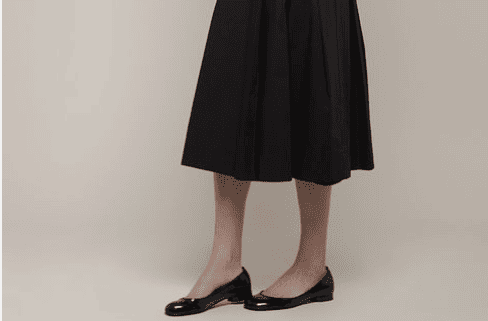1950s women’s fashion was marked by elegance and femininity. The hourglass silhouette dominated, with fitted waists and full skirts emphasized by petticoats. Shirtwaist dresses and pencil skirts were common, while the iconic poodle skirt emerged as a trend among younger women. High heels, pearls, and hats were popular accessories, and pompadour hairstyles added a polished touch.
I’ll uncovers the timeless allure of ’50s fashion, revealing why it’s still giving today’s trends a run for their money. Get ready, fashion history class is in session!
One of the most iconic elements of 1950s fashion is the poodle skirt. This full, swinging skirt was a favorite among teens and young women. It represented fun, frivolity, and a touch of rebellion, -Dr. Valerie Steele, Director and Chief Curator of The Museum at the Fashion Institute of Technology.
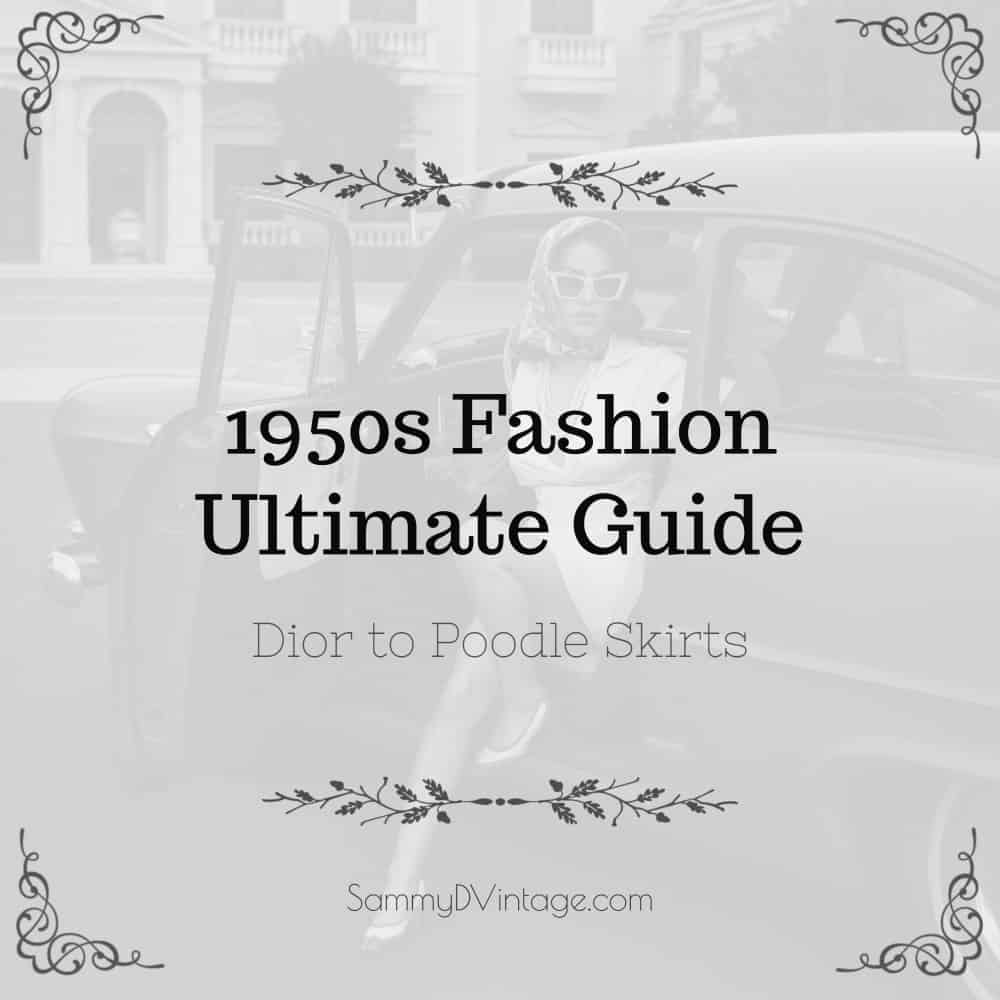
“Vertigo,” the 1958 Alfred Hitchcock classic, was more than a stunning thriller—it was a testament to the fashion renaissance that was transforming the landscape of the decade.
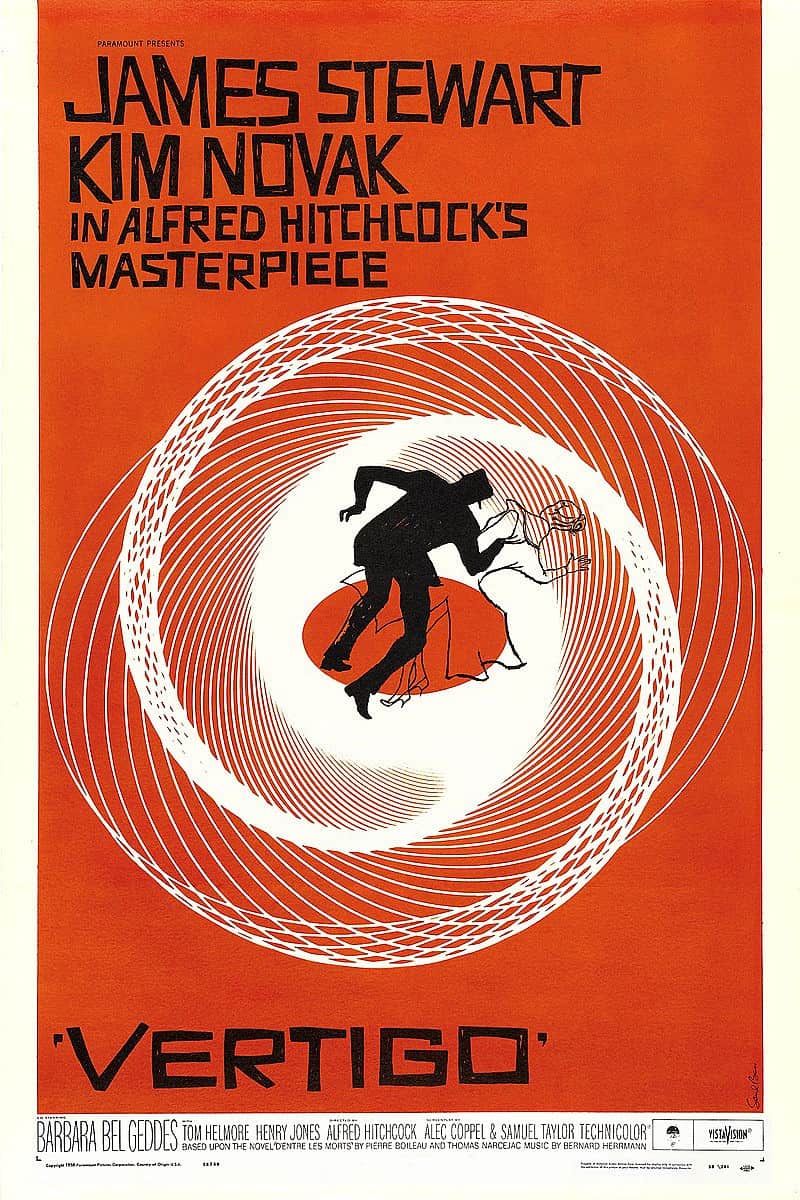
Kim Novak, epitomizing the 1950s woman in all her contradictory allure, stands poised in silhouette, donned in that iconic gray suit by Edith Head—a symbol, perhaps, of the poised, tailored, Dior-inspired elegance of the era.
What did that revolution look like? Let’s turn our gaze back to Dior’s 1947 “New Look”—a title given in amused astonishment by Carmel Snow, the editor-in-chief of Harper’s Bazaar at the time, as the French designer’s daringly feminine line shook off the utilitarian austerity of war-time fashion.
Dior’s cinched waists and voluminous skirts ushered in a decade that would witness a brilliant tapestry of innovation and tradition, challenge and conformity.
The 1950s: A Decade of Fashion Revolution
The 1950s was a transformative period that saw the likes of Marlon Brando oozing rebellious charm in his leather jacket and Christian Dior revolutionizing women’s attire with his ‘New Look.’ This decade witnessed an evolution from the austere post-war period to an era that celebrated individuality and bold style choices.
And as the decade progressed, the ‘new’ in the New Look gave way to bolder, even more vibrant expressions of style. Just think of the poodle skirts, billowing out in concentric circles, a petticoat’s dance captured in mid-twirl, a staple for any teenybopper worth her Bobby-soxer salt.
This playful, youthful style was just as significant to the 1950s fashion narrative as Dior’s sophisticated, ladylike aesthetic.
Designers like Cristobal Balenciaga, Charles James, Hubert de Givenchy, and Carolyn Schnurer left an indelible imprint on this era. Balenciaga brought structure and shape to his designs, giving a modern edge to the feminine silhouette.
Charles James, the architect of fashion, lent artistic brilliance with his sculptural gowns. Givenchy offered an understated elegance with his refined collections. Schnurer, on the other hand, popularized ethnic prints and designs, weaving a global narrative into fashion.
From the glamorous influence of Hollywood stars like Marlon Brando to the ground-breaking innovations of designers like Christian Dior, 1950s fashion was a remarkable testament to creativity and progress.
So, buckle up your saddle shoes, slip into your virtual poodle skirts, and join us as we unveil the indelible imprint of 1950s fashion on the world.
Differences in Fashion from Previous Decades
As we swivel our mirrors to reflect the decade that preceded the 1950s, we find a stark contrast in fashion. The 1940s were marked by a spartan practicality dictated by the grim necessities of war.
Outfits were governed by strict rationing and the need for utility—Hemlines rose, silhouettes were boxy, and fabrics were restricted.
The emphasis was on conservative and simple outfits that were versatile and functional. The suits were slim, the dresses were plain, the colors were muted, and the extravagance was, in a word, absent. This was an era when fashion bowed its regal head to the more pressing demands of the world stage.
With the arrival of the post-war period, transformative currents swept across various facets of life, including politics, society, and, significantly, fashion. The unprecedented economic prosperity of the 1950s, a spectacle not witnessed for decades, acted as a crucial catalyst in the dramatic evolution of fashion that unfolded during this time.
Freed from the austerity of wartime, fashion swung like a pendulum from the lean, utilitarian 1940s to the glamorous, abundant 1950s.
The explosion of prosperity and the rise of the middle class brought about a sea change in the way people dressed. No longer constrained by war-time rationing, the newly affluent public clamored for more luxurious, detailed, and eye-catching attire.
This was a decade when the world, in its newfound vibrancy, turned to fashion as an expression of optimism, progress, and individuality.
The 1950s fashion undeniably bore unprecedented significance. The transformative styles of this era transcended the boundaries of mere aesthetics and became a cultural touchstone—a means to project newfound prosperity, a mirror reflecting shifting societal norms, and a weapon for the emerging youth and feminist movements to challenge traditional conceptions of what women should look like.
As we delve into the tapestry of the 1950s fashion narrative, we uncover a vibrant and rich story of a decade when the world, and its fashion, emerged from the shadows of war into the sparkling technicolor of a new dawn.
We’ll conclude with details on some of the most famous fashion influencers of that time. Keep reading to learn more about this fascinating era of fashion.
Women’s Fashion in the 1950s
The fabulous fifties saw a cavalcade of memorable outfits for women. It was a decade when style met elegance in a dance of dazzling designs.
From the luxuriant gowns of high society to the chic simplicity of the suburban housewife, there was a whirlwind of fashion moments that defined the era.
These outfits, whether they were for a glam night out or a casual day in, bore the unmistakable stamp of 50s flair and finesse.
“The New Look” by “Christian Dior”
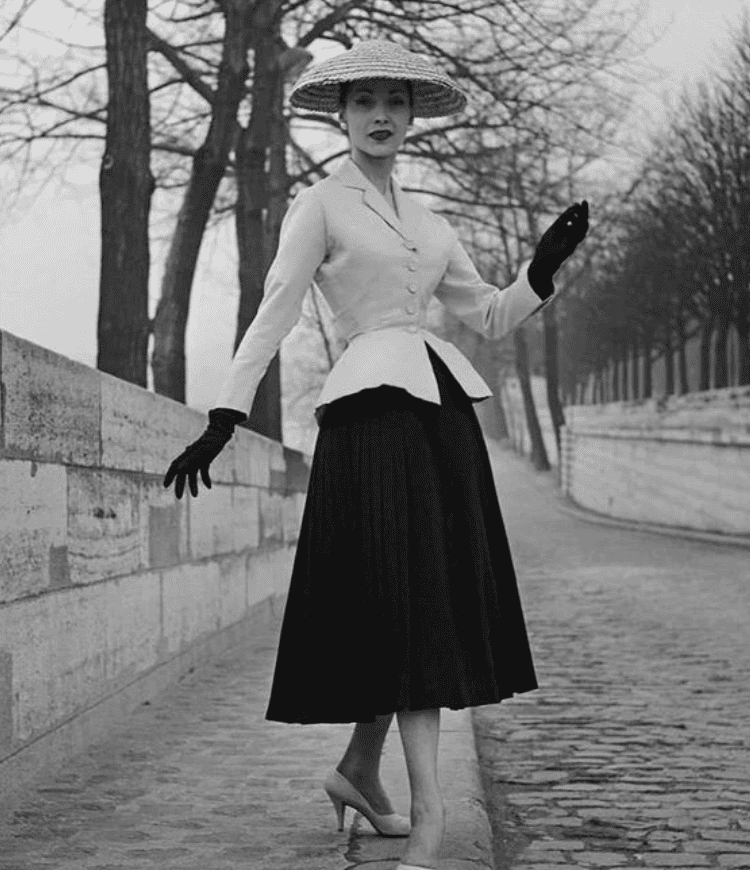
Dior’s revolutionary ‘New Look‘ was the cornerstone of 1950s fashion. With its nipped-in waist, padded hips, and voluminous skirt, this silhouette was a dramatic departure from the austerity of the war years. This was fashion reborn—overflowing with femininity, elegance, and an intoxicating allure.
“Charles James” Clover Leaf (1953)
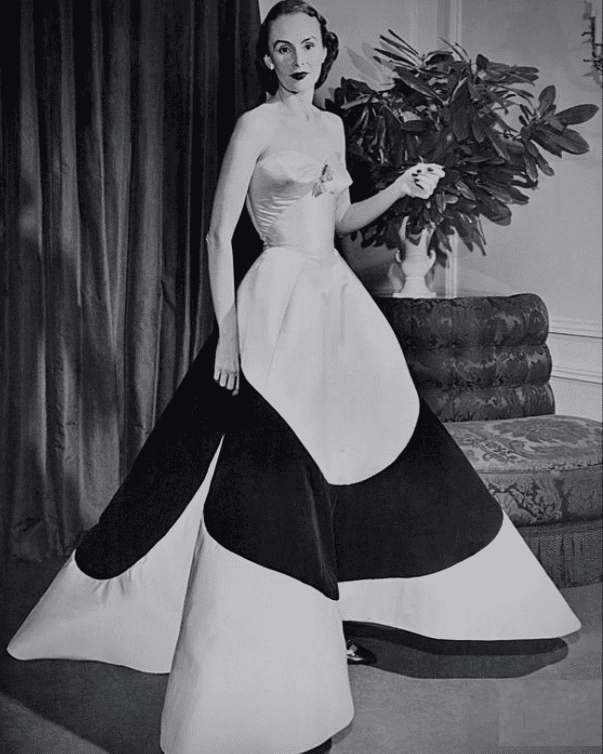
Charles James, a British-born fashion designer, was well known for his structural and complex designs. His iconic Clover Leaf dress, first designed in 1953, perfectly embodied his unique approach to fashion design.
The Clover Leaf dress was an architectural marvel, the culmination of James’ masterful understanding of fabric and form. It featured a complex construction of four sections, each resembling a leaf of the clover.
The attire boasted a meticulously crafted, off-shoulder top and an exquisite skirt that extended from the hips and cascaded into four striking points, presenting the semblance of a four-leaf clover from an aerial perspective.
Fabricated with satin, velvet, and tulle layers, the dress was engineered to impeccably complement the wearer, highlighting the waistline and hip region while adding an element of drama with its distinctive construction.
Sophie Gimbel’s Cocktail Dress

Sophie Gimbel, a notable American fashion designer and the leading lady of Saks Fifth Avenue’s Salon Moderne, was renowned for her elegant cocktail dresses. Gimbel’s cocktail dresses of the 1950s embodied the decade’s charm with their fine tailoring, luxurious fabrics, and intricate detailing.
These dresses often featured classic silhouettes with fitted waists and full skirts inspired by Dior’s ‘New Look.‘ However, Gimbel was not afraid to experiment, often incorporating elements of drama and glamor such as oversized bows, rich embroidery, and extravagant use of lace.
Her cocktail dresses are celebrated as epitomes of 1950s sophistication, influencing 50s fashion trends and the concept of American elegance.
Poodle Skirt by Juli Lynee Charlot
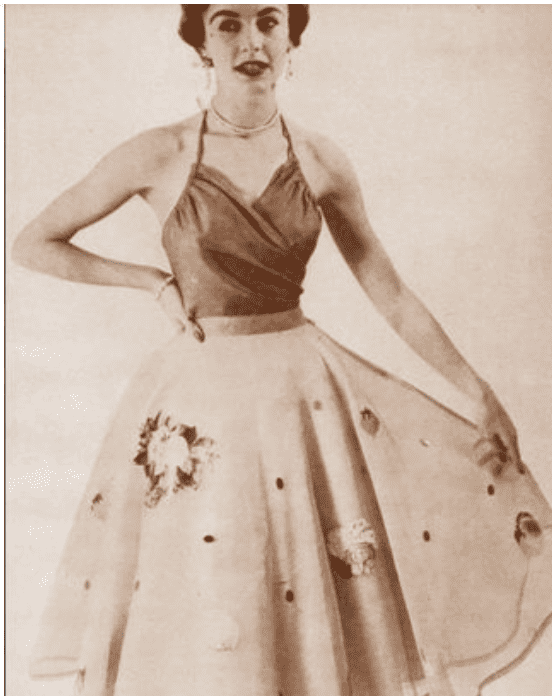
The poodle skirt is an iconic symbol of 1950s fashion, largely popularized by designer Juli Lynne Charlot. These skirts, typically made from felt fabric, were characterized by their wide, circular-cut, and knee-length hem.
The defining feature, however, was the appliqué of a poodle, often leashed by a sequined or beaded cord, hence the name “Poodle Skirt.” Charlot initially created these skirts as a solution to not having anything to wear for a holiday party.
The skirts quickly gained popularity for their unique, playful design and the ease with which they could be worn and danced in, becoming a staple in every 1950s teen girl’s wardrobe.
Balenciaga Evening Dress
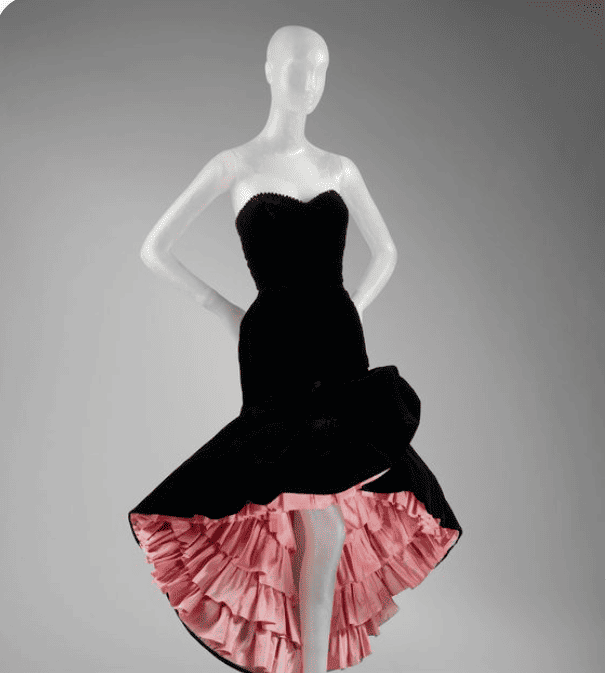
Cristóbal Balenciaga, a Spanish designer hailed as “The Master” of haute couture, was renowned for his innovative and sculptural designs. His evening dresses of the 1950s, in particular, stood out for their dramatic silhouettes and fine craftsmanship.
Balenciaga’s evening gowns often featured intricate details such as ornate embroidery, delicate lacework, and extravagant use of luxurious fabrics like silk and satin.
These gowns, whether featuring a voluminous skirt or a more streamlined silhouette, were always impeccably tailored and refined. Balenciaga’s designs continue to be celebrated for their timeless elegance and his unique ability to combine simplicity with high drama.
Pencil skirts
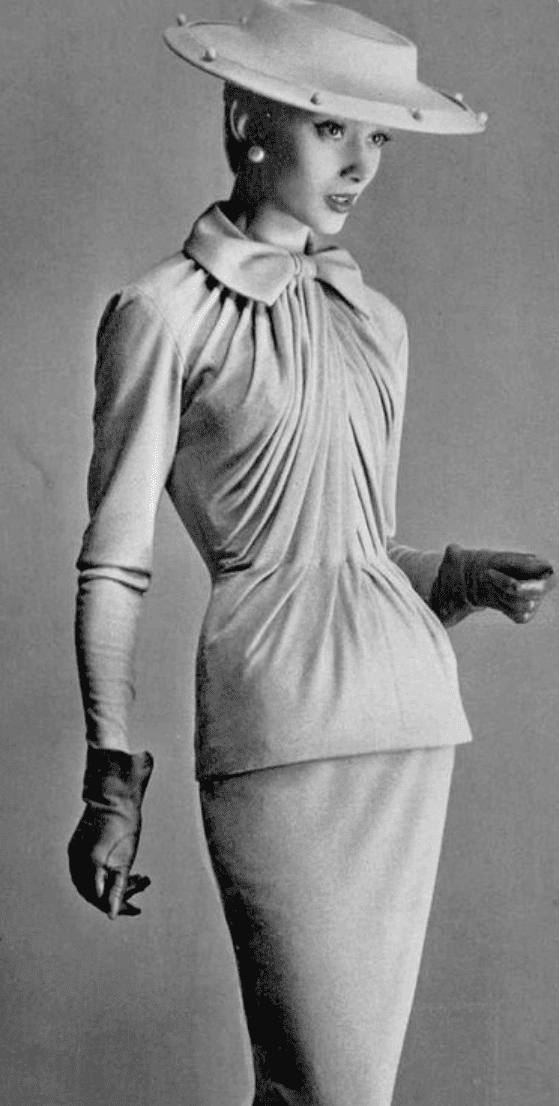
Source: Pinterest
Pencil skirts, classic components of women’s attire, surged in popularity during the 1950s. These slim-line skirts, with their straight and narrow design, typically reach to or slightly past the knee, and are designed to offer a snug fit.
It’s named for its pencil-straight line and was introduced by French designer Christian Dior as part of his “H-Line” collection of 1954.
Evolution of the Silhouette
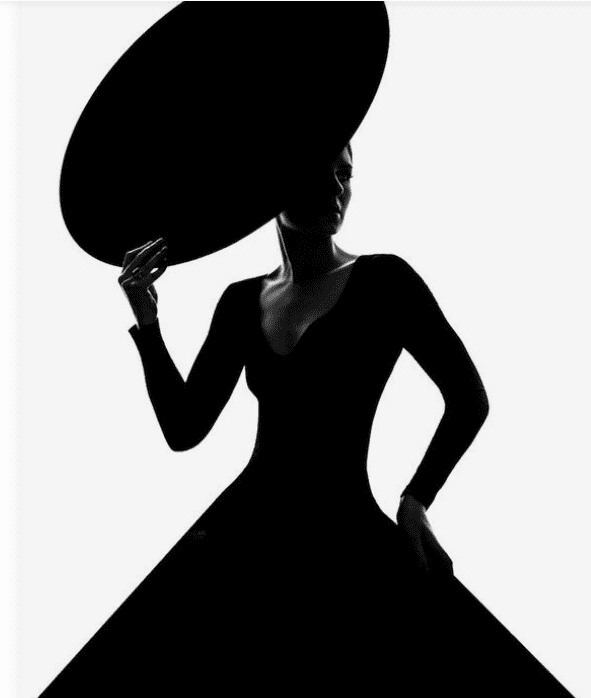
Source: Pinterest
The 1950s brought an evolution in silhouette, moving away from the boxy shapes of the 1940s towards a more sculpted look. Waistlines cinched to waspish proportions, and skirts billowed in a sea of petticoats. It was all about the hourglass figure, accentuating a woman’s natural curves.
High-Waisted Trousers

Source: Pinterest
Trousers with a high waistline, combined with a neatly inserted button-front top, provided a balance of laid-back sophistication and ease. The adaptability and practicality of this style made it an ideal choice for a variety of settings, including work and recreational activities.
Cropped Denim Pants
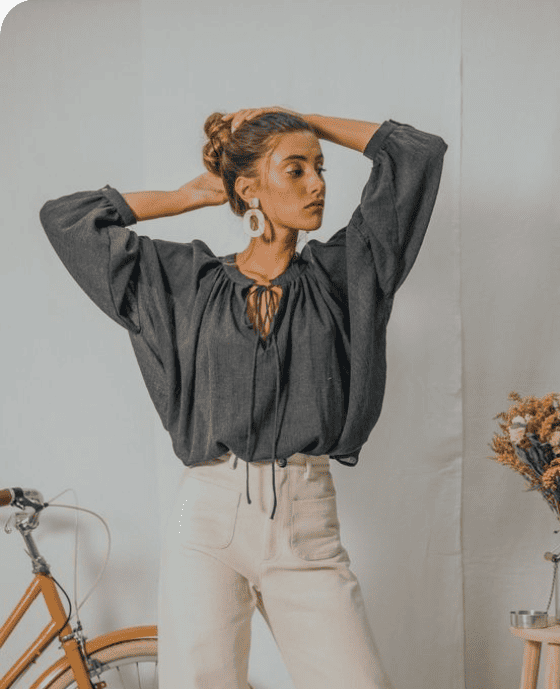
Source: Pinterest
Cropped denim trousers, a flowing top, and a pair of level shoes assembled an outfit that was both easygoing and fashionable. Ideal for a laid-back day, this ensemble encapsulated the youthful exuberance and liberating mood of the time.
Gingham Dress
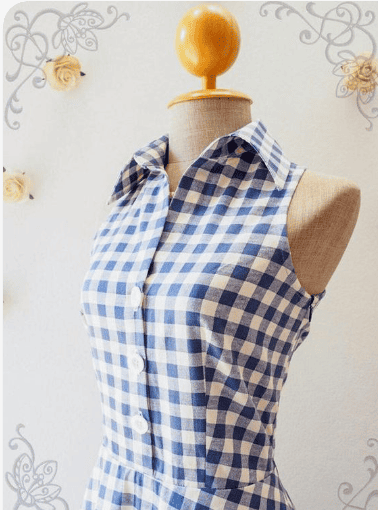
Source: Pinterest
Gingham, with its cheery checkered pattern, was a popular choice for dresses in the 1950s. A gingham dress paired with low heels was a sweet, simple, and chic look. Whether it was worn for a summer picnic or a casual day in town, this ensemble always delivered a dose of sunshine style.
Strapless Dresses
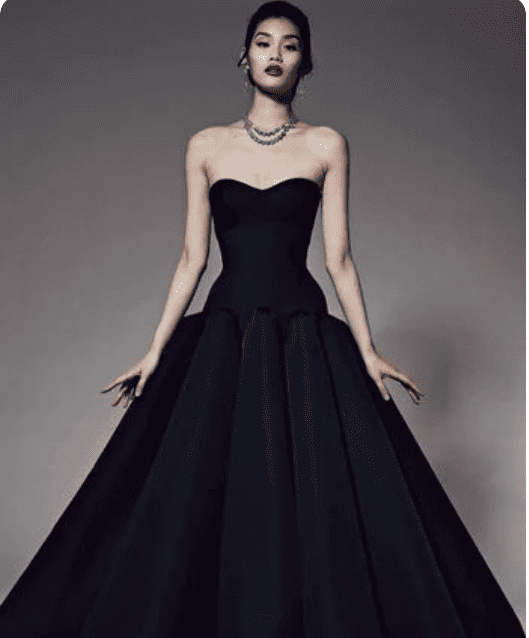
Source: Pinterest
Strapless dresses, typically fashioned from satin or chiffon, frequently showcased decorative elements such as lace or embroidery. These became a preferred choice for official events, frequently paired with gloves and an eye-catching necklace for a complete look.
Blouses
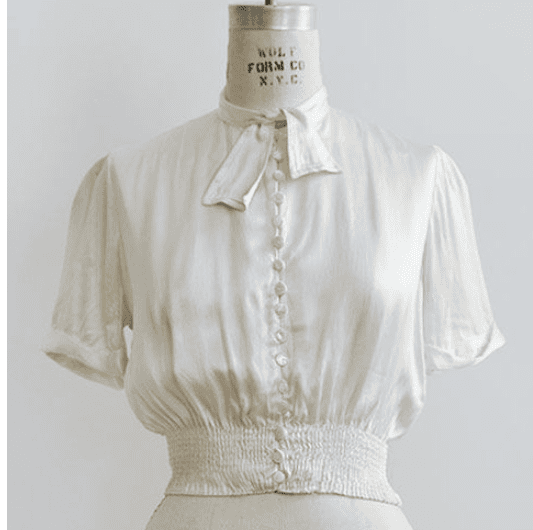
Source: Pinterest
Blouses formed the bedrock of feminine attire in the 1950s. Typically crafted from translucent materials like silk or chiffon, these garments frequently boasted ornamental features like lace or embroidery. Their versatility made them a favored selection for both daytime and evening ensembles.
Sweater Sets

Source: Pinterest
Sweater sets were a popular choice for casual wear in the 1950s. They consisted of a matching sweater and skirt or pants. They were often made of wool or acrylic fabric and were a popular choice for both day and evening wear.
50s Women’s Shoe
Source: Pinterest
Footwear in the 1950s ranged from practical to glamorous. Low-heeled pumps, often in coordinating colors with one’s dress or suit, were a popular choice for everyday wear.
Saddle shoes were favored by teenagers, especially when paired with poodle skirts. For a more casual look, ballet flats and loafers were widely worn. And for that touch of glamor, nothing beats a pair of high-heeled stilettos.
Accessories
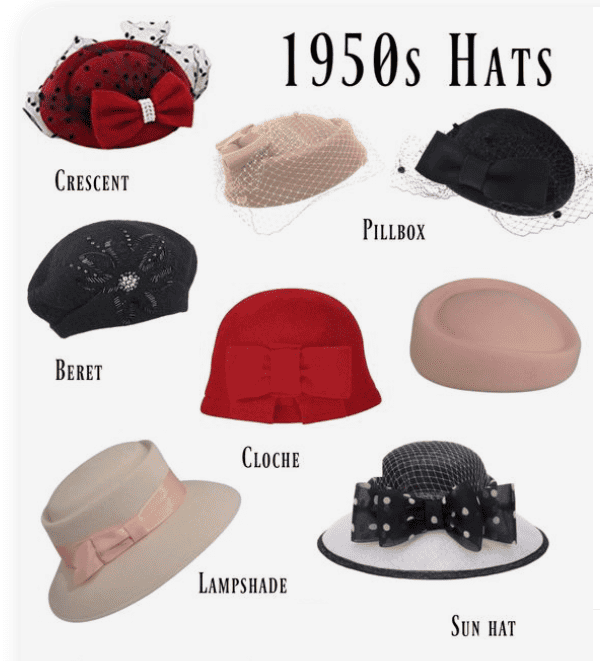
Source: Pinterest
In the 1950s, women loved their accessories. Hats, ranging from wide-brimmed sun hats to chic pillbox styles, were very much in vogue. Gloves, too, were a must-have, worn for church, formal events, and sometimes even for shopping.
Pearls were the decade’s favored jewelry, whether as necklaces, earrings, or bracelets. Handbags were often small and coordinated with one’s outfit. Belts, too, were a significant accessory, emphasizing the era’s adored cinched waist look.
All in all, the 1950s was an era of sartorial splendor, where fashion was used to express newfound prosperity, societal roles, and personal style. The decade’s women’s fashion, from dresses to accessories, was a testament to a time when style began to celebrate femininity, individuality, and a zest for life.
Men’s Fashion
Men’s fashion in the 1950s was a blend of traditional elegance and a growing casualness, largely driven by post-war societal changes and economic boom. The decade was marked by the coexistence of conservative suits and the emergence of relaxed, leisure-inspired styles.
Here are some of the key elements:
Suits
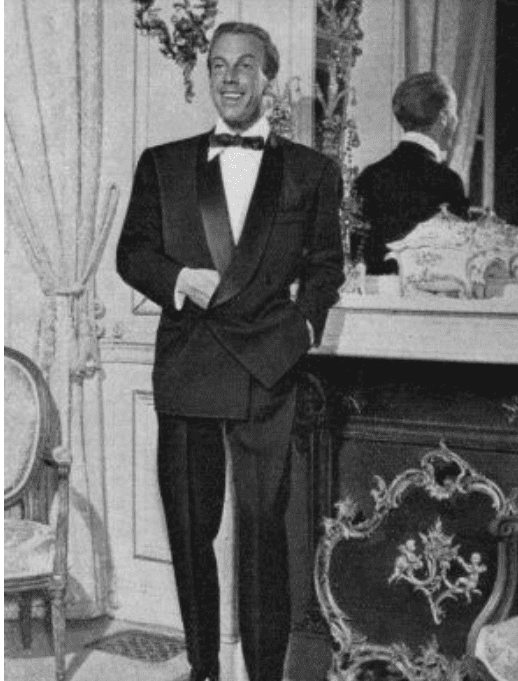
Source: Pinterest
During the 1950s, suits were an essential component of a gentleman’s attire. The common design included jackets with a single row of two or three buttons, expansive lapels, and a tapered waist to manifest a pronounced, wide-shouldered silhouette. Grays, blues, and browns were popular color choices.
Dress Shirts
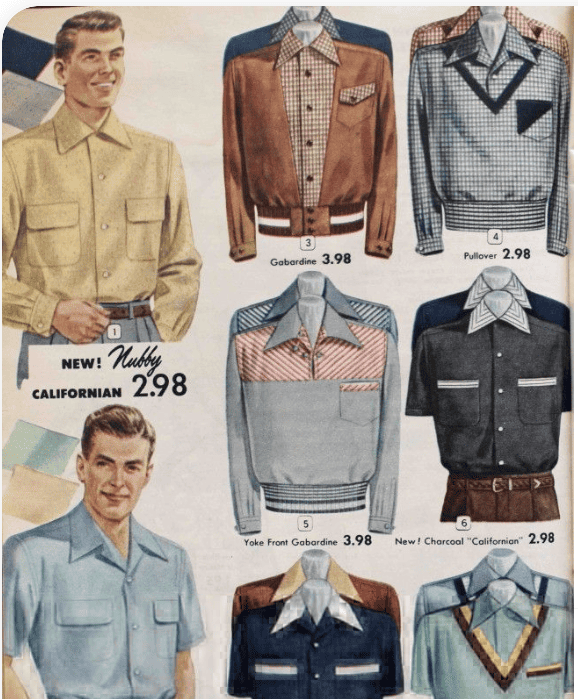
Source: Pinterest
Dress shirts were usually white or pastel-colored, often paired with ties featuring bold designs or vibrant colors. On the casual side, Hawaiian shirts and flannel shirts were also popular.
Trousers
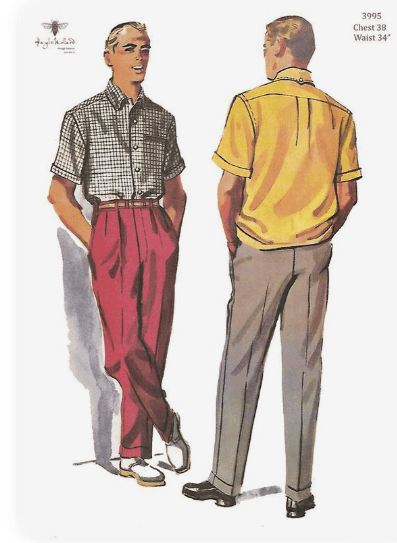
Source: Pinterest
Dress pants were standard wear, often high-waisted and with a sharp crease down the front. They were generally wider at the thigh and tapered towards the ankle. Denim jeans also began to gain acceptance, especially among the younger generation, signifying the growing casualness of men’s fashion.
Pleated Trousers
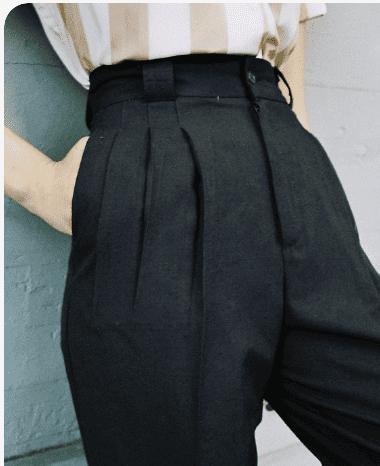
Source: Pinterest
Pleated trousers were a key element of men’s fashion in the 1950s. The extra fabric at the waist provided more room for movement, making these trousers both comfortable and stylish. They were typically worn high on the waist and were tapered at the bottom, offering a sharp, clean silhouette.
Revere collar shirt
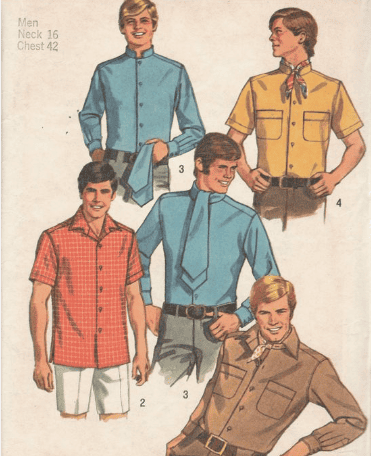
Source: Pinterest
The Revere collar shirt, also known as the camp or Cuban collar shirt, was a popular choice for casual wear in the 1950s. These short-sleeved shirts were characterized by a wide, open collar and often came in bright colors and patterns, adding a splash of the exotic to a man’s summer wardrobe.
Footwear

Source: Pinterest
Footwear such as oxfords and brogues with lace-up designs were the go-to choices for formal events, whereas slip-on shoes like loafers gained favor for relaxed settings. As the decade was drawing to a close, athletic shoes began to infiltrate the core of everyday men’s attire.
Leather Jacket
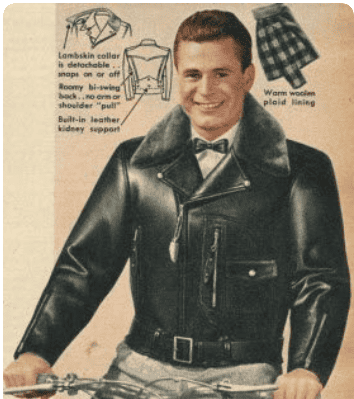
Source: Pinterest
The 1950s saw the rise of the leather jacket as a symbol of rebellious cool, thanks to Hollywood stars like Marlon Brando and James Dean. These jackets were typically black, featured a wide collar, and were cut at waist length.
Harrington Jacket
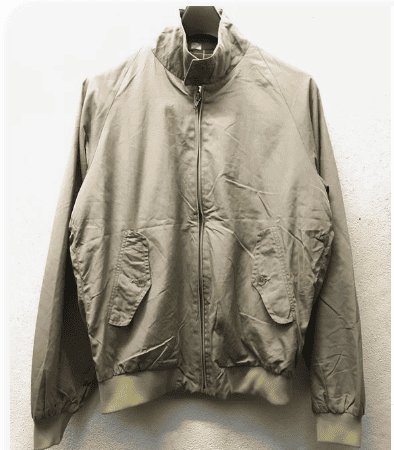
Source: Pinterest
Harrington jackets, also known as Blouson or bomber jackets, were a popular outerwear choice in the 1950s. These jackets were characterized by their waist-length cut and elasticated waistbands and cuffs. Sport coats, worn with contrasting trousers, also gained popularity during this time, allowing men to mix and match their outfits.
50s Men Hats
Hats remained a significant part of men’s fashion. Fedora hats were a common choice, and for a more casual look, men often wore flat caps or straw boater hats.
50s Men Accessories
Accessories like tie clips, cufflinks, and pocket squares were essential to complete a man’s look.
In essence, the 1950s was a transformative period in men’s fashion, bridging the gap between formal dress codes and a growing emphasis on comfort, leisure, and personal style.
Kids’ Fashion
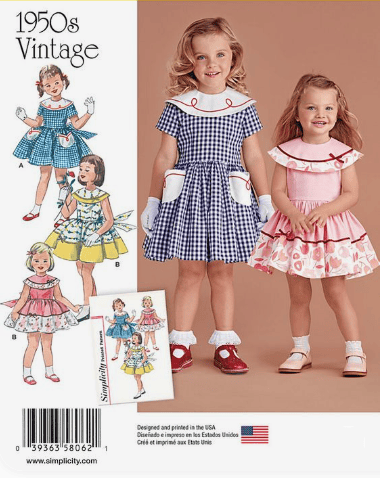
Source: Pinterest
Joseph Love, an American designer in the 1950s, was known for his charming contributions to children’s wear. His designs echoed the fashion trends of adult clothing, bringing an element of miniature sophistication to young girls and boys’ wardrobes.
Love’s creations for girls featured natural waistlines, full skirts, and puffed sleeves alongside dropped waists, smock dresses, pinafores, and bold patterns.
For boys, his designs incorporated colorful and patterned short-sleeved, collared shirts, knitted sweaters, and cardigans. His collection reflected the transitional era of the 1950s, where traditional aesthetics met playful designs, offering both comfort and style to the younger generation.
1950s Girls’ Fashion

Young girls in the 1950s typically wore dresses that echoed the styles of their mothers. The dresses were often designed with natural waists, full skirts, and puffed sleeves – a mini version of Dior’s “New Look.”
However, as the decade progressed, more practical clothing began to surface for girls. This included blouses and skirts, smock dresses, and pinafores, available in bold colors and playful patterns.
A novelty item popular among girls was the poodle skirt, emblazoned with a poodle appliqué; it was a favorite choice for social gatherings and dances.
Over the course of the decade, pants became more acceptable for girls, though they were generally reserved for less formal occasions or outdoor activities.
Accessories were an important part of a girl’s outfit. Just like their mothers, girls wore shiny black patent leather shoes and white socks. Ribbons and bows were popular hair adornments.
1950s Boys’ Fashion
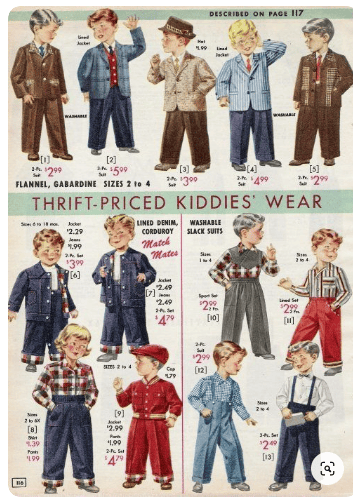
In the 1950s, boys’ clothing started to become more casual and functional, moving away from the traditional formal style of previous decades. While young boys still wore suits for formal occasions, it became increasingly acceptable to wear jeans and casual shirts for everyday activities.
Shirts in vibrant colors and patterns, like checks and stripes, became fashionable. Sweaters and cardigans were also favored as they were easy to take off or put on depending on the weather. For footwear, sneakers began to gain popularity, signaling a shift towards comfort and practicality.
For very young children, overalls and rompers were common choices, as they were easy to put on, comfortable for play, and easy to launder. These often came in sturdy fabrics like denim and cotton and, for girls, might feature frills, ribbons, or other decorative touches.
In essence, children’s fashion in the 1950s followed the style cues of adult fashion, but a shift towards more practical, comfortable, and kid-friendly clothes was beginning to emerge, setting the stage for the more relaxed styles of the decades to follow.
Youth Subcultures

Source: Pinterest
The 1950s were a period of burgeoning youth subcultures, each epitomizing its unique fashion. For example, the ‘Greaser‘ look, shaped by the rock n’ roll era, featured key elements like leather outerwear, crisp white tees, and denim trousers.
Conversely, the ‘Preppy‘ trend showcased a different array of staples, encompassing chinos, slip-on shoes, and knitted sweaters.
Teddy Boys a subculture of youth in the 1950s that was known for their sharp, tailored suits. They often wore suits with drape cuts, skinny ties, and loafers, and they often had slicked-back hair.
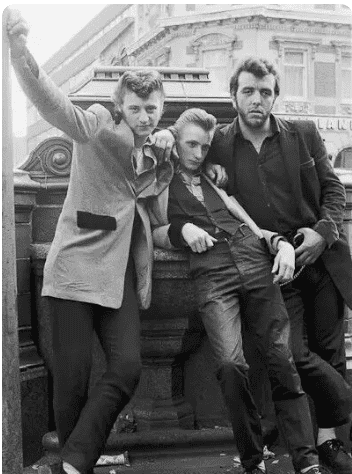
Source: Pinterest
The Rise of New Synthetic Materials
The 1950s marked the advent of synthetic materials in clothing manufacturing, and children’s fashion was no exception. Materials like polyester and nylon began to be used extensively in children’s clothes.
These synthetic fabrics were durable, resistant to wrinkles, and, most importantly, easy to launder—a key consideration for children’s clothing, given the wear and tear kids can subject their clothes to.
Some Notable 50s Fashion Icons
Here are some influential fashion icons from the 1950s who profoundly reshaped the fashion landscape during that time:
1. Audrey Hepburn
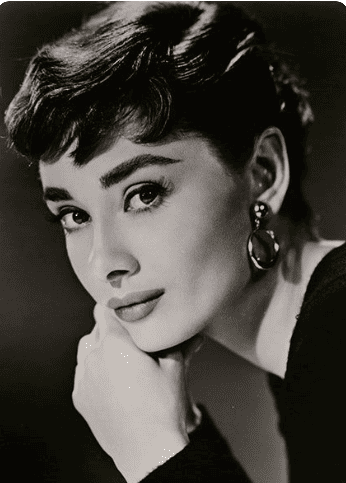
Audrey Hepburn, a style symbol of enduring grace and elegance, was a leading fashion influencer during the 1950s. She is revered for her performances in films like “Roman Holiday” and “Sabrina,” and she infused a refined, minimalist aesthetic into the fashion of that era.
Frequently photographed in figure-accentuating dresses, understated tops, and narrow black trousers, her wardrobe choices were a striking divergence from the customary voluminous outfits of that period.
However, arguably her most memorable fashion moment was the petite noir dress tailored by Givenchy for the film “Breakfast at Tiffany’s,“ ascending to become one of the most legendary dresses in fashion history. The timeless sophistication and unstudied glamour of Hepburn’s style persist in guiding contemporary fashion trends.
2. Marilyn Monroe
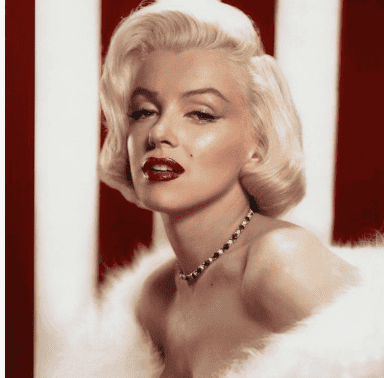
Marilyn Monroe, one of Hollywood’s most enduring icons, was an influential figure in 1950s fashion. Known for her glamor and sensuality, Monroe embraced styles that emphasized her hourglass figure.
She is known for bringing into mainstream fashion figure-embracing outfits, high-necked tops, and high-rise two-piece swimsuits, challenging the conventional notions of femininity and allure during her time.
One of her most recognized fashion moments involves the creamy-white, high-necked dress she wore in “The Seven Year Itch.” This particular outfit is famously associated with the unforgettable scene in which the dress flutters about her while she is positioned above a subway vent.
Monroe’s personal style and her on-screen costumes alike helped to define the fashion of the 1950s, emphasizing both glamor and feminine allure.
3. Grace Kelly
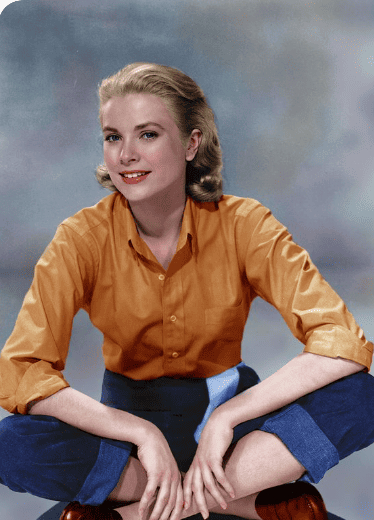
Grace Kelly, the Hollywood starlet who became a real-life princess, was a major style icon of the 1950s. Her fashion sense was characterized by timeless elegance and understated glamor.
Known for her classic, tailored clothing, she often wore shirtwaist dresses, capri pants, and twin sets, exuding a polished yet effortless sophistication.
Her wedding dress, designed by Helen Rose, featured a high collar, long sleeves, and a full skirt made of silk, taffeta, and antique Brussels lace.
Her style epitomized the classy and feminine fashion of the 1950s and continues to inspire women today.
4. Elizabeth Taylor
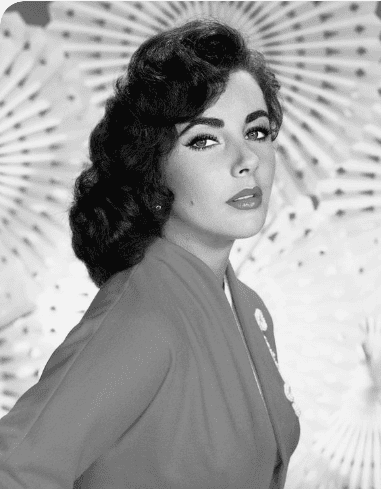
Elizabeth Taylor, a standout Hollywood star of the 1950s, had a significant impact on the fashion of the era. She was renowned for her stunning beauty and glamorous style; Taylor embraced fashion that was bold, luxurious, and always opulent.
She often wore strapless gowns, fitted at the waist and flared at the hips, that showcased her hourglass figure. Her love for extravagant jewelry also set trends, with her collection including some of the world’s most famous diamonds.
Perhaps her most iconic look was the white floral dress from “A Place in the Sun,” which epitomized the feminine elegance of 1950s fashion. Taylor’s style was a unique blend of Hollywood glamor and daring personal expression.
5. James Dean
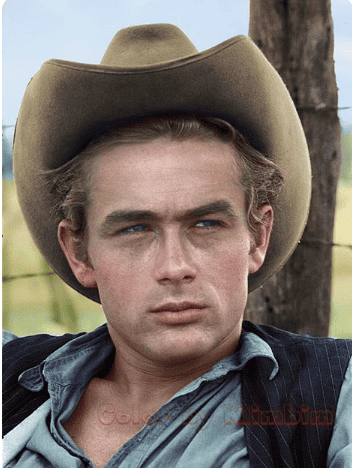
James Dean, who personified the sense of adolescent discontent in the 1950s, emerged as a significant style symbol of the time. His role as a defiant youngster in “Rebel Without a Cause” fashioned a novel narrative for young males’ stylistic choices.
His characteristic ensemble, a basic white t-shirt, denim trousers, and a red windbreaker, brought forth an offbeat and casual vibe that was groundbreaking for its era.
Additionally, his inclination for leather jackets and denim jeans in films like “East of Eden” and “Giant” had a significant impact on the period’s prevalent fashion trends.
Dean’s nonchalant style captured the zeitgeist of the youthful generation, solidifying him as a perennial icon of rebellious coolness.
6. Marlon Brando
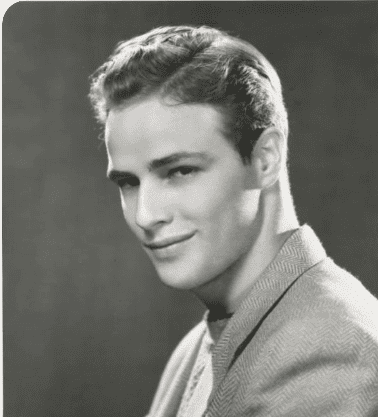
Marlon Brando, with his effortless charisma and undeniable talent, had a profound influence on men’s fashion in the 1950s. Brando’s portrayal of rebellious characters in films like “A Streetcar Named Desire” popularized the casual and rugged aesthetic.
He made the white t-shirt, denim jeans, and leather jackets iconic wardrobe items, symbolizing a rebellious, non-conformist attitude.
His signature style often accessorized with a cap or a motorcycle hat, became emblematic of the ‘bad boy‘ image of the era. Brando’s fashion influence extended beyond the silver screen, impacting the way young men across America and the world dressed, helping to make casual wear more mainstream.
These Hollywood icons not only reflected the fashion trends of the 1950s but also played a significant role in shaping them, influencing the style choices of millions of people around the world.
During the 1950s, individuals like Kim Novak were central to the fashion upheaval, whose refined elegance and bespoke sophistication encapsulated the spirit of the era. Innovative and audacious designs by fashion icons such as Christian Dior, Charles James, Cristobal Balenciaga, and Sophie Gimbel carved an enduring mark on the decade.
Simultaneously, Hollywood luminaries like Audrey Hepburn, Marilyn Monroe, Grace Kelly, Elizabeth Taylor, Marlon Brando, and James Dean shaped the fashion narrative of the decade, each injecting elements of elegance, glamour, and dissent into the unique blend.
Reflecting on the 1950s, we perceive more than mere fashion trends; we witness a vibrant and transformative period that sculpted our current understanding and interaction with fashion—an era that championed personal expression, welcomed transition, and, above all, bravely pushed the confines of style.
Indeed, the 1950s served as compelling proof of the immense capacity of fashion to mirror its era and stimulate evolution.

